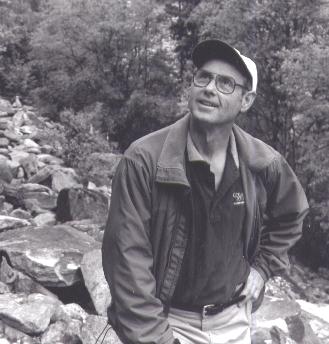 | ||
ABOUT MYSELFMy interest in trail construction developed while I was employed at Selkirk College as a Faculty Assistant in Environmental Sciences. In addition to my regular work responsibilities I was quite active within the Environment and Outdoors Club, and with the assistance of a dedicated associate (Peter Wood), the Club activities evolved from lunch-hour discussions about biology toward more challenging and meaningful environmental work such as the construction of hiking and ski-touring trails. Our cumulative efforts contributed greatly to the early development and acceptance of the Brilliant Overlook Trail and established a strategy for the protection of this rugged area. There were many challenges to come, but the ground work was done for meeting them.
It, and all my subsequent work, was driven by my vision of a trail system which would be far more than a collection of recreational pathways. To my mind, a well designed trail had to meet several criteria. It had to offer scenic viewscapes as it coursed through a natural landscape. This landscape should not be monotonous, but rather it should display variations in terrain and a diversity of ecosystems. There should be opportunities for interpretive enhancement, either through the presentation of local history or from the environmental perspective. And - as much as possible - such a trail should run out of sight from the hustle and bustle of modern life, so that it would offer to the user ample opportunities for a re-connection to unspoiled nature. Perhaps, such a trail might even change a life, subtly altering one's perspective from that of the all-conquering hero of the modern age to a more modest spiritual being linked in thought to simpler times and humbled by solitude and starlight. Luckily, there was ample available terrain in the Castlegar vicinity which allowed me to pursue these ideals. Local stretches of the Columbia and Kootenay rivers offered wonderful possibilities for exploring the many tenuous threads which bind us to the past. I have tried to follow these threads with the numerous interpretive sign panels I have developed along the trails, and with the additional information provided by me in this website. My essays on local history have produced unforeseen results: the full Albert McCleary story was only made possible when a connection was made with the Ontario descendants of the elusive Castlegar pioneer, and a mystery in the Ole Skattebo story was solved by a contributor from Oslo, Norway. These developments were possible only because my material was freely available on the world-wide web. Generally, I was able to obtain external funding grants for all the new projects. As funding agencies will not commit funding for maintenance aspects of the projects when completed, I initiated a system of voluntary contributions above the basic membership level so that the FPT Society would have adequate revenue for trail maintenance and liability insurance, the two biggest operating expenses. Response by the membership was generous so that at peak membership level, roughly $3,000 was available annually for these tasks. I would like to thank all those members who contributed so generously with time and money so that the investment in the admirable trail system which resulted would be protected and maintained. During my years of association with the FPT Society I effectively managed all aspects of trail construction and maintenance, and much of the promotion. This included the procurement of all necessary funding, mainly from corporate sponsors, such as BC Hydro, Columbia Power Corporation, Aquila Networks Canada (now Fortis BC), and others. I found the many working relationships, which were based on mutual trust as well as faith in what could be accomplished, one of the most rewarding aspects of my work over the past decade. I left the FPT Society early in 2005 to continue on my own with work that I was passionate about: to develop interpretive values for the trails I had worked on, to encourage contemplative walking as an exercise for both body and mind, and to popularize local history. This website is my current vehicle for doing that. A significant part of this effort has been original work, based on new research. It is my intention to expand and redevelop the website information into two related books:
TRAILS IN TIME: Time Windows
2007: redesign and replacement of the remaining history panels on the Millennium Walkway 2007: development and installation of the Brilliant Dam history panel for Columbia Power Corporation (at the rest stop on Highway 3A) 2008: development and installation of eight history panels for Castlegar Spirit Square (in front of the City Hall) 2011: development and installation of orientation sign for Zuckerberg Island Heritage Park. | ||
|
All rights reserved. Information is provided for personal use only. Use in any other application without permission is forbidden. |
